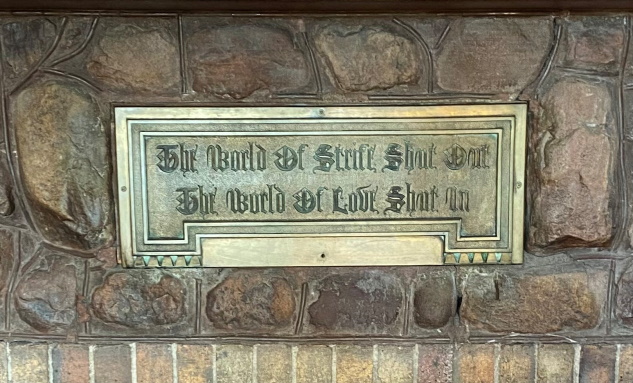Features
Nu Chapter Marks a Century in the Governor's Mansion
In 2022, Nu Chapter marked one hundred years of owning its chapter house at the University of Kansas, a record within the Fraternity. To commemorate this centennial event, The Delta commissioned this feature to share the story of how the Knights of Nu Chapter found their home.
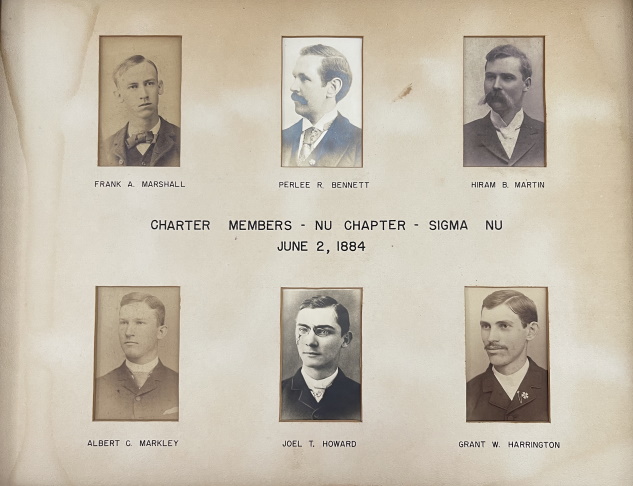 How It Started:
How It Started:
Chartered in the Summer of 1884 as the first active Sigma Nu chapter west of the Mississippi, Nu Chapter arranged for its earliest members to meet in various boarding houses and rental properties to conduct chapter business without occupying residential premises together until the commencement of the 1910-1911 fall semester. In May of 1910, the chapter’s house corporation purchased a newly constructed residence immediately north of the university campus, at 1246 Oread Avenue, for $5,000 cash and an $8,000 purchase-money mortgage.
The new house suited the chapter favorably from the outset. A three-story frame house, it admitted twenty-two boarders and a live-in caretaker. Nu Chapter membership stabilized through World War I.
Following the War’s conclusion, chapter membership flourished – and with this growth came a realization that Nu Chapter had outgrown its chapter house less than a decade after buying it. Dwelling capacity couldn’t hold the active membership. Dining space and sanitary conveniences proved inadequate. During the 1920-1921 school year, thirty-eight active brothers – nearly twice its stated capacity – lived in the chapter house, with another twelve Brothers staying off-premises and the house caretaker living in a nearby apartment.
Three Nu Chapter alumni – Grant Harrington (Nu 4), Elmer Engel (Nu 23), and Dick Williams (Nu 250) – were instrumental in leading the House Corporation’s quest for new, expanded housing. With Williams taking the lead, Nu Chapter launched an ambitious plan to obtain a new chapter house. That plan yielded almost unimaginable results.
Williams’ Target for a New Chapter House: The Stubbs Estate.
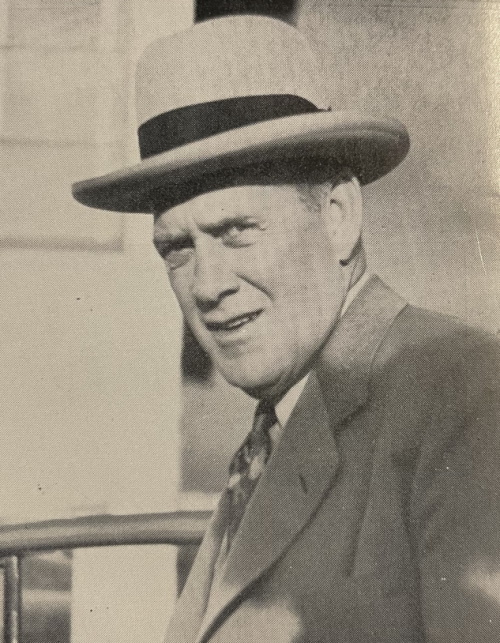 Describing his plan for new housing for Nu Chapter today, it’s safe to say that Dick Williams “went big.”
Describing his plan for new housing for Nu Chapter today, it’s safe to say that Dick Williams “went big.”
Walter Roscoe Stubbs housed his family in a stately mansion on estate-sized grounds, built in fourteen weeks during 1907 just west of the university campus during his third term as a Kansas State Representative for Douglas County, Kansas. In 1909, Stubbs would become Kansas’ Eighteenth Governor. Stubbs served two terms in that role until 1913, when he and his family returned to the estate west of Lawrence, Kansas.
Due to his electoral successes, Governor Stubbs’ family estate was commonly known as “The Governor’s Mansion” to locals. The premises lived up to the title. Occupying space historically known as “Windmill Hill” due to the presence of a notable Dutch windmill that represented the highest scenic perch in Douglas County until burning down in 1905, the house was the design of John Haskell, Kansas’ State Architect, a Lawrence native whose work represented most of the noteworthy Nineteenth Century architecture in and around Lawrence. Haskell was nearing the end of his remarkable career when Stubbs commissioned the design of a Georgian Colonial structure in the style of “the great Southern plantations.” Stubbs sought a home that would be a suitable residence for his family while accommodating the business and social obligations of a public official.
Haskell delivered the goods: buff brick exterior walls two feet thick, protecting from extreme Kansas temperatures of both Summer and Winter; four white pillars ranging two stories on the east; three stories of finished space – appointed by rich mahogany paneling, hardwood floors, multiple fireplaces, several oversized bathrooms, commercial kitchen space with an adjoining oversized dining room, screened porches on the south and open porches on the north and east – all perched atop a full basement. The entire third floor was a ballroom with a stage featuring a flight of stairs leading to a widow’s walk atop the house. As originally designed by Haskell, the house had twenty-two bedrooms capable of accommodating more than fifty residents at any one time. It was an uncharacteristically enormous residential structure for its time, measuring eighty by one-hundred twenty feet.
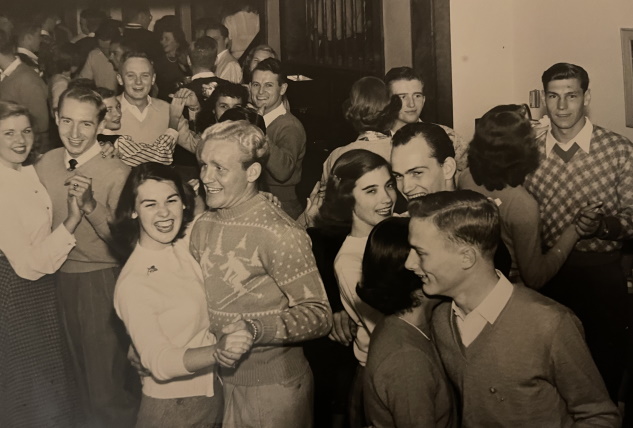 Word circulated throughout Lawrence and the region, beginning in 1920, that business opportunities elsewhere rendered Stubbs willing to part with The Governor’s Mansion and its surrounding acreage “for the right price.” Williams was aware of this and knew three other KU fraternities had already made inquiries ahead of Sigma Nu, but had all balked at the high asking price. Williams also knew that having reduced its mortgage on the initial Oread Avenue Chapter House to about $1,000 in only eight years, the house corporation possessed some formidable financial clout. He believed that, despite lenders’ resistance at the time to extending commercial loans on fraternal dwellings, he could leverage the house corporation’s financial strengths to meet Governor Stubbs’ price demands where all other prospective buyers declined to do so. Williams sought lodging that would last longer than the first chapter house and could house Nu Chapter as its growth continued. In the Stubbs Mansion, Williams saw the perfect solution to Nu Chapter’s housing dilemma: distinctive lodging representing the physical embodiment of the unique spirit of Nu Chapter and Sigma Nu Fraternity.
Word circulated throughout Lawrence and the region, beginning in 1920, that business opportunities elsewhere rendered Stubbs willing to part with The Governor’s Mansion and its surrounding acreage “for the right price.” Williams was aware of this and knew three other KU fraternities had already made inquiries ahead of Sigma Nu, but had all balked at the high asking price. Williams also knew that having reduced its mortgage on the initial Oread Avenue Chapter House to about $1,000 in only eight years, the house corporation possessed some formidable financial clout. He believed that, despite lenders’ resistance at the time to extending commercial loans on fraternal dwellings, he could leverage the house corporation’s financial strengths to meet Governor Stubbs’ price demands where all other prospective buyers declined to do so. Williams sought lodging that would last longer than the first chapter house and could house Nu Chapter as its growth continued. In the Stubbs Mansion, Williams saw the perfect solution to Nu Chapter’s housing dilemma: distinctive lodging representing the physical embodiment of the unique spirit of Nu Chapter and Sigma Nu Fraternity.
Williams bargained directly with Governor Stubbs and cut this deal in January 1922: a $52,000 purchase price for the house and the grounds, with $15,000 from Central Trust Company of Topeka as a direct payment to the Governor secured by a first mortgage on the premises; a swap with Stubbs of the Oread Avenue chapter house for an additional $15,000 credit, which the Governor immediately conveyed to the Alpha Chi Omega sorority for $15,000 in cash (a deal which Williams had effectively brokered in advance); and the Governor’s agreement to accept a second mortgage on the family estate for the $22,000 balance due at eight percent interest. The house corporation approved the financial terms of the agreement reached between Williams and Governor Stubbs in January 1922, and the sale of The Governor’s Mansion to Nu Chapter closed within days. Nu Chapter had a new home just in time for the spring semester to begin.
Opening Impressions of a New Chapter House
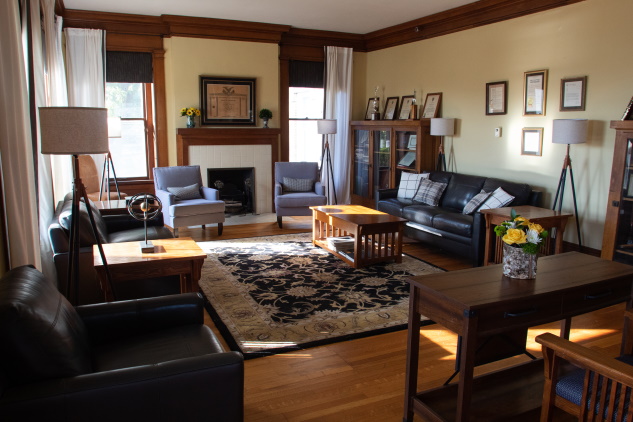 By acquiring the entirety of the Stubbs’ family estate on Windmill Hill, Nu Chapter became the owner of not just The Governor’s Mansion but also its extensive grounds. Twenty-eight and one-half acres featured the residence located at its crest, while including several appealing exterior attributes: ample wooded areas, rugged ravines, spacious grassy lawns, and a private lake. Few other fraternity chapters in the country could claim such a turf as the base for chapter operations; certainly, no other KU fraternity could convincingly assert such a claim.
By acquiring the entirety of the Stubbs’ family estate on Windmill Hill, Nu Chapter became the owner of not just The Governor’s Mansion but also its extensive grounds. Twenty-eight and one-half acres featured the residence located at its crest, while including several appealing exterior attributes: ample wooded areas, rugged ravines, spacious grassy lawns, and a private lake. Few other fraternity chapters in the country could claim such a turf as the base for chapter operations; certainly, no other KU fraternity could convincingly assert such a claim.
In keeping with Williams’ intentions, Nu Chapter now held distinctive property matching what Harrington, Engel, and Williams each sought: a site for chapter operations that reflected the very unique character of the Fraternity. At the time of the purchase, the national officers of the General Fraternity claimed that Nu Chapter now possessed “the largest fraternal estate in the world.” While no official confirmation of that assertion can be found through research, no challenge has been offered to rebut it.
The active membership occupied the new chapter house on January 26, 1922. What Harrington, Engel, and Williams foresaw – chapter quarters that couldn’t be outgrown – would unwittingly become the next quest. There was no doubt that the new chapter house, with its spacious interior living space and its substantial grounds, stood in immediate contrast to the overcrowded space left behind on Oread Avenue to all the men who shifted to the Governor’s Mansion in 1922.
Notably, the brass plaque on the main fireplace in the entry hall and adjacent to the original dining room – left behind by the Stubbs family – eloquently memorializes both the family’s and the Fraternity’s presence in The Governor’s Mansion: “The World Of Strife Shut Out, The World Of Love Shut In.” For Governor Stubbs, the plaque was a continual reminder of the “Bleeding Kansas” era during and following the Civil War, when hostilities frequently erupted between free-state “Jayhawkers” and militants holding differing views. What wasn’t fully understood by the men of Nu Chapter as they first occupied their new chapter house was the plaque’s foretelling of the Stubbs Mansion as a constant safe-haven for its members over the coming century, without regard for the variety of social unrest, which might arise outside those walls.
Featured Memories from One Hundred Years In Residence
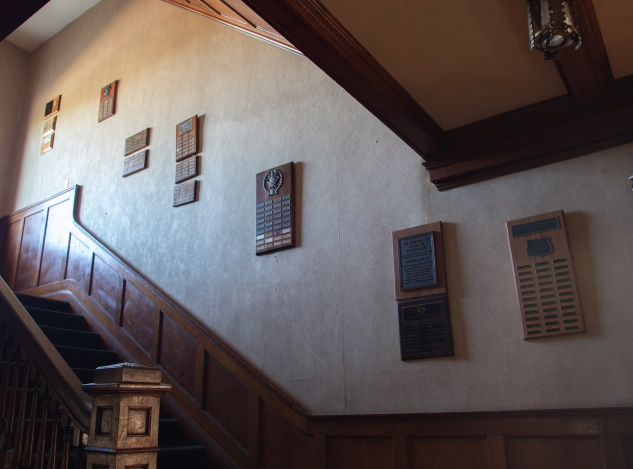 None of the brothers who moved from Oread Avenue to The Governor’s Mansion in 1922 remain with us today. Undergraduate collegians then, all of them would today verge upon their one-hundred-twentieth birthdays. Their impressions of their new fraternal digs from a century ago are known via third-party narratives.
None of the brothers who moved from Oread Avenue to The Governor’s Mansion in 1922 remain with us today. Undergraduate collegians then, all of them would today verge upon their one-hundred-twentieth birthdays. Their impressions of their new fraternal digs from a century ago are known via third-party narratives.
Still, multiple alumni across the generations have volunteered their impressions and recollections about The Governor’s Mansion. Permit the sharing of a few noteworthy perspectives stemming from a century of Nu Chapter ownership of the Stubbs family estate.
B. J. Hinkle (Nu 757) turned one hundred years old in July 2022, born some six months following the purchase of the Stubbs estate. Active in Nu Chapter for more than seventy-five years, Hinkle is one of the very few Nu Chapter alumni to serve as Eminent Commander of the collegiate chapter, elected President of the house corporation, and as the Presiding Officer of its philanthropic branch, the Harrington-Holloway Foundation. The Chapter House’s entry hall was dedicated to Hinkle and his sons, David (Nu 1522) and James (Nu 1551), for the family’s contributions to Nu Chapter.
Hinkle no longer hears very well – but offers two observations about The Governor’s Mansion that resonate.
Sharing his very first impression of the chapter house, Hinkle supplies a perfect summation: “Uniquely elegant.”
Hinkle’s most enduring memory about the Chapter House reflects his ongoing patronage as an alumnus. He cites how the alumni leadership – particularly during the stewardship of Dick Williams – always adapted the quarters to suit the residents’ needs, from modest renovations in the 1940s and 1950s to the addition of “The Williams Wing,” named in homage to Williams’ tireless work on behalf of Nu Chapter, in the late 1960s, followed by cosmetic upgrades to common areas and living quarters.
Hinkle is not alone. Al Higdon (Nu #1008) transferred from Wichita State University, then Wichita University, as a rising junior for the fall semester in 1956. Higdon entered the Interfraternity Council’s “Formal Rush” process for Greek-letter houses intending to pledge with KU’s Sigma Chi chapter – but found himself being recruited quite persuasively by Nu Chapter’s Eminent Commander. Higdon’s initial impression of the chapter house echoes that shared by his contemporaries, characterizing it as “awesomely, classically impressive” and citing its residential uniqueness against all other Greek-letter houses he toured as his major attraction to Sigma Nu.
As for his living experience, while dwelling in the chapter house, Higdon’s focus deviates from the structure and focuses on the “eclectic, interesting and varied group of guys with whom I lived, merging the best of student leaders, academic scholars and varsity athletes all together in a single place.”
In September 2022, Tom Rost (Nu 990) toured The Governor’s Mansion with a news feature crew from Wichita’s PBS affiliate. Rost echoed the themes identified by Hinkle and Higdon during his interview, noting the architectural uniqueness of the original house and its thoughtful preservation through renovations big and small during one hundred years of occupancy. The journalist interviewing Rost was astounded by the marvelous condition of the original mahogany paneling and woodwork on the first two floors despite what the interviewer called “a century of fraternity exposure,” which Rost attributed to one simple fact: “This has never been an institutional dwelling to those who’ve lived here. It’s still what it was built to be: somebody’s home. That’s how it has been treated.”
During the Spring of 1966, Bob Matejka (Nu 1245) – already admitted to the University of Nebraska – joined a high school friend for a visit to KU, where the friend’s cousin happened to be a Sigma Nu. As Matejka puts it, “The Stubbs Mansion blew me away! Nothing like it on the Nebraska campus. I decided to attend KU and pledge Nu Chapter on that trip.”
Matejka’s time at KU involved a changing social dynamic. Rabid protests over the Vietnam Conflict and civil rights injustices raged across campus in that era. University buildings were burned by demonstrators in April 1970, prompting the relocation of traditional graduation ceremonies for Matejka’s class the following month. The National Guard patrolled campus daily during those years, and Nu Chapter brothers stood guard outside the chapter house most nights. “The World Of Strife Shut Out...” still resonates with the Brothers of Matejka’s era.
Matejka was one of a few members who lived in both the original Stubbs Mansion and the renovated chapter house before and after the Williams Wing additions took place during and after his freshman year. Expansions of the kitchen and dining hall, all new sleeping dorms, the addition of a first-level chapter room, and more upstairs residential quarters all transpired that year. Matejka treasures the chance to have dwelt in both the “old” and “new” versions of The Governor’s Mansion while an active member of Nu Chapter.
Similar insight echoes the thoughts of Brothers Hinkle, Higdon, Rost, and Matejka. The chapter house’s distinctive exterior appearance and uniquely appointed and named living quarters have been noted by dozens of other brothers when recalling their interest in pledging Nu Chapter. From “The Coal Bin” in the basement, through “The Ice Box,” with access to a huge second-floor outdoor porch, and “The Hi-Fi,” a former small third-story attic room immediately beneath the widow’s walk atop the house, no two residential rooms are the same. That’s unique at KU to the Sigma Nu chapter house.
That matters in recruitment, according to several brothers. After a freshman year spent in a university dormitory, the lack of a “cookie-cutter” residential floor plan wooed Rod Beeler (Nu 1506). For Mike Zevitz (Nu 1677), the historic majesty of the Governor’s Mansion’s exterior left him “awestruck.” Recruited during the 2007 re-establishment, following the suspension of Nu Chapter’s Charter in 2005, Jordan Herbert (Nu 2199) recalls “admiring” the chapter house’s exterior at first but ultimately being wowed by “sharing down time” in the residential rooms and common areas of the house with his contemporaries. Herbert recalls meeting his pledge class for the first time – different guys with different backgrounds from different places – and treasuring a unique character matching the novelty of their quarters, which resonates with him to this day.
Marking the Century
After a century in The Governor’s Mansion, Nu Chapter anticipates its next century eagerly. If these walls could talk, they’d surely tell marvelous tales. The entry hall fireplace, however, speaks majestically for those walls: “The World Of Strife Shut Out, The World Of Love Shut In.”
